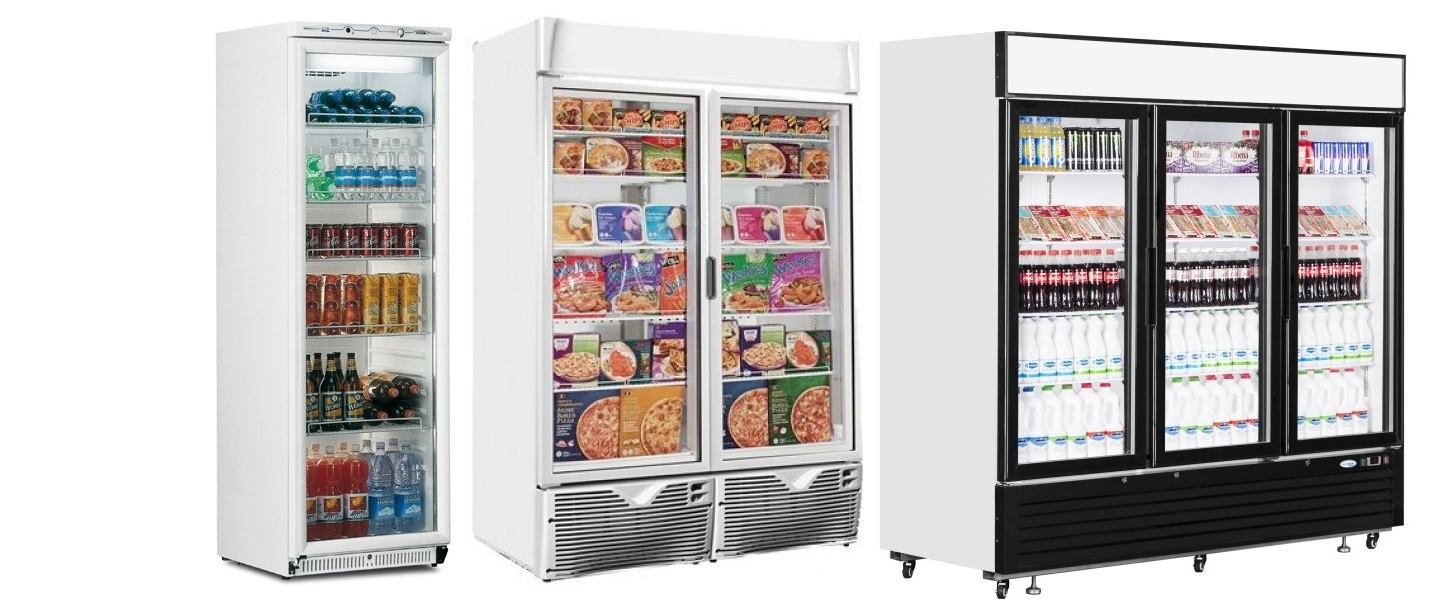
Keeping produce chilled to the ideal temperature whilst still advertising attractively can be a tall order; this is where quality commercial display refrigeration enters to solve all of your problems.
Understanding all elements of these glass door chilled displays ensures that you make the right decision the first time and finalise a wise purchase for your business.
Table of Contents
What Is Display Refrigeration?
Why Buy Commercial Display Refrigeration?
Types of Display Refrigeration
Temperature Ranges Explained
Size and Capacity
Positioning and Placement
Cooling and Defrost Functions
Refrigerants Explained
Key Specifications and Features of Display Fridges and Display Freezers
Optimising Efficiency
Understanding Power
Cleaning and Maintenance
Choose your Warranty
When Can You Expect Delivery?
Ask Advice
What is Display Refrigeration?
Display refrigeration is basically a piece of equipment that holds and preserves contents in low temperatures whilst giving clear visibility of produce. Convenience stores, bakeries and other shops are just a few types of business that utilise the glass door and refrigerated body to show off their products clearly and effectively.
Glass door displays provide the ideal way to store chilled drinks or fresh food items safely whilst also merchandising produce attractively to the customer to boost sales. Perfect for self-service, glass door refrigeration offers customers the opportunity to browse what's available at choose at their leisure.
The term is quite a broad one that includes, not only the typical cabinet fridges and freezers that you would expect to find, but also other styles of equipment designed to effectively present stock and achieve maximum visual impact. Read more here about the different types of commercial display refrigeration available.
Why Buy Commercial Display Refrigeration?
If you want a piece of display refrigeration for your business it's vital that you opt for commercial equipment. Designed specifically for use in tough environments, all commercial equipment is fully tried and tested to guarantee performance and efficiency under even the harshest conditions.
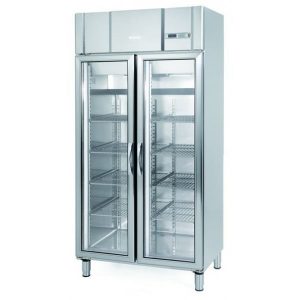
With commercial refrigeration you can typically expect:




Types of Display Refrigeration
The term 'display refrigeration' is an umbrella term for any commercial fridge or commercial freezer with a glass door.
Both Commercial Display Fridges and Commercial Display Freezers are available in upright or undercounter styles, the common feature being the full length glass door. Undercounter display fridges and undercounter display freezers feature only a single door. Upright fridges offer the option of single door, double door or triple door designs, each with increasing capacities to ensure that every sized business can find a unit to suit their needs. Upright glass door freezers are also available with single, double and triple door options.
Wall site freezers are also available: a common feature typically in large shops and supermarkets. These units combine a chest freezer style base with either fridge or freezer cabinets at the top creating a versatile refrigerated display merchandiser.

Temperature Ranges Explained
All commercial refrigeration is designed to hold consistent temperatures. Fridges will typically range somewhere between -1˚C and 10˚C while freezers will often generate temperatures somewhere within -10°C and -25°C. This is suitable to meet all standard refrigeration needs.
Size and Capacity
Size and capacity are closely linked - obviously the larger the size of a unit the more potential capacity is created. Your choice of upright or undercounter cabinets should obviously be clear simply by carrying out a quick site survey of the available space.

Top Tip: It is vital to always ensure that you have accurately measured the intended space meant for housing the equipment. This should take into account the necessary space for airflow and any potential access issues with regards to the opening and closing of hinged doors.
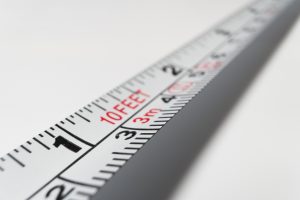
Undercounter fridges and freezers are defined as being under 900 mm in height meaning that they can be slotted beneath existing counters or work surfaces to fully utilise all available space. They will range in capacity from 105 up to 170 litres with widths up to 610 m and depths up to 670 mm (including handles).
Upright cabinets, as the name suggests are tall freestanding units with single, double or triple door layouts. Models can offer up to 2050 litres of capacity with maximum height of 2055 mm, width of 2079 mm and depth of 800 mm.
With a full host of capacities and dimensions available there's plenty of choice to cater for every size requirement. Always remember to allow for adequate airflow around equipment - even refrigeration needs to breathe!

How Many Shelves?
Directly related to the size and capacity of any display refrigeration is the number of shelves it can accept. Obviously, the larger the equipment the more shelves will come as standard. Shelves will often be adjustable to allow more personalised organisation of stock.
Consider the materials from which the shelves are made. All commercial grade shelves should be strong enough to withstand the weight of multiple produce without bowing or bending. Generally, upright display units will offer 3 to 12 shelves, while undercounter models have 2 to 3 shelves. Some models suitable for use in kitchens are gastronorm (GN) compatible making it easy to move multiple ingredients and dishes in one motion, perfect in time-sensitive situations such as during a busy service.
Positioning and Placement
Glass door refrigeration is most often placed in front of house areas where the primary aim of presenting products to the customer whilst being held in appropriate temperatures can be fully utilised. While the majority of equipment is designed for this exact purpose, some brands do manufacture display fridges that can be positioned in commercial kitchens. These display chillers can operate and perform in higher ambient conditions typically experienced in a working kitchen.
Also Good for the Kitchen...
Some chefs prefer glass door refrigeration as is allows for quick location of products during busy services. If you're looking for a display fridge suitable for kitchen placement, take a look at the Foster EcoPro G2 range or Staycold range of equipment. Both are available as single or double door fridges.
Allow for Airflow
All refrigeration requires airflow, so bear this in mind when choosing a site to position your equipment. Aim to allocate at least a 5cm air gap around the entire exterior of the equipment.
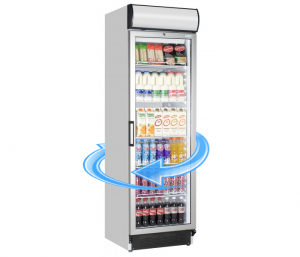

When addressing the intended positioning of your equipment also consider whether your proposed model has under mounted or top mounted refrigeration systems. This refers to the location of the actual mechanics of the fridge or freezer, the components that actual chill or freeze contents. This can be easily identified by simply looking for where the vents are visible. Under mounted being placed at the bottom below the main display cabinet and top mounted being placed above.
Under mounted Vs Top Mounted
| Under Mounted | Top Mounted |
| Draws air from lower down where temperatures are cooler | Less dust and debris can be drawn into vents and fans etc. |
| Ideal for premises for low ceilings | Cold air is heavier so it falls down through the cabinet as it leaves the evaporator |
| Refrigeration in base raises the cabinet level making it easier to access both for customers and when restocking | Any hot air generated by the cabinet will raise up away from the display |
| Components are easier to access during servicing and maintenance | Refrigeration components are at less risk of damage from accidental kicking or knocking of trolleys |
Cooling and Defrost Functions
Glass door refrigeration, as will other forms of commercial equipment can operate with a number of cooling and defrost types. The best combination for your business will often depend on the results you expect and the amount of time you have to put into maintenance.
Cooling
Static - Cold air circulates naturally throughout the cabinet. While this saves on energy, it can result in uneven and inconsistent temperatures and pockets of warm air.
Fan Assisted - Fans are used to circulate cold air evenly around the cabinet for more consistent display conditions. Foster Refrigerator cabinets in the EcoPro G2 range such as the EP700G single glass door fridge are fitted with 'Circular II' cooling air distribution systems to guarantee optimum internal air flow even when the unit is fully stocked.
Defrost

Automatic/Electric - Electric elements heat the evaporator to thaw any build-up of ice. This operates on a predefined factory set cycle with no need for manual intervention however operating costs may be higher. Water formed by the melted ice is collected in a condensate tray situated near to the motor. The heat produced during the refrigeration cycle evaporates the water.
Manual - A hands-on process that involves emptying contents from the fridge/freezer, switching the unit off and removing any ice build-up by hand. If opting for a manual defrost system, never use sharp tools to pierce the ice as this could result in puncture or damage to the equipment.
Off Cycle - This function involves the refrigeration cycle being stopped and refrigerant being prevented from entering the evaporator. This causes the cabinet to gently heat therefore melting any ice build-up that may have formed. The period of time which the refrigeration cycle is paused will often be controlled with a factory set timer.
Key Specifications and Features of Display Fridges and Display Freezers
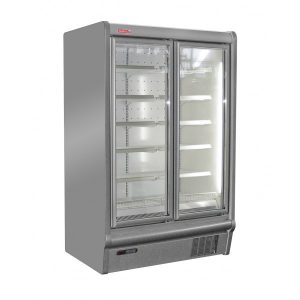
Glass door refrigeration, as with all commercial equipment, offers a host of features to enhance performance and make use that little bit more convenient. Whether included as standard or options to consider, paying attention to the details can make sure you get the perfect display for your business.
- The aesthetics and design of refrigerated displays tend to be more attractive than solid door alternatives. This is due to the fact that displays are designed to aid the sale of products and enhance desirability in front of house areas. An ugly piece of equipment will reflect badly on all items stocked. With glass doors or glass surround, you can kit out your business with a display that complements your business style.
- Some single door units have the option of right or left hinged doors to accommodate for all layouts and to eliminate any potential obstacles.
- If looking for a unit with multiple doors there will often be a choice of sliding or hinged function. You may find that sliding doors are the only option due to limited space and access, however, these are generally harder to maintain than hinged alternatives as dirt and grime can easily build-up and clog the runners reducing overall performance. Where there is a choice to be made, hinged doors are advised.
- The exterior finish should be chosen to complement the décor and design of your business. With different finishes to choose from the perfect product for your individual requirements is there somewhere.
- Do you need castors? Some free-standing models, whether fridge or freezer, feature castors, either as a full set or positioned only at the rear. This provides increased manoeuvrability when moving the equipment in general and during cleaning operations. Obviously, commercial refrigeration can be very heavy and so castors make everything a lot easier.
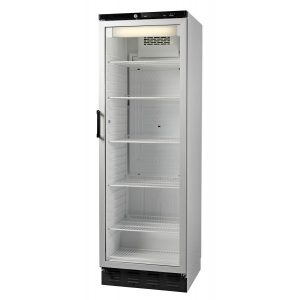
- Lighting is a major feature for any display. Presenting your products in the best possible light is vital to maximising sales and increasing the visibility of contents.
- Self closing doors can be handy especially in busy areas where frequent access is required. Eliminating the risk of accidentally leaving doors ajar, a self-closing feature can make sure that your unit always performs to its fullest potential, giving consistent temperatures and increased efficiency.
- Make sure products are always clearly visible with anti-mist glass.
- Easy to use controls and clear temperature displays not only makes operation simple but also means that monitoring of display conditions can be carried out quickly.
- All displays will have either adjustable or fixed shelves. If you're continuously updating and changing your stock, adjustable shelves are ideal as they allow you to tailor the height between shelves to create an eye-catching layout that fully shows off your products. Adjustable shelves can also help to ensure that maximum use of the total capacity can be made, leaving minimal wasted space.
- Security is never a bad thing. Some units are designed with a lock as standard to add a level of protection for stock during out of hours periods.
- The noise level or number of decibels generated during operation is especially important when refrigeration is being positioned in public areas. Obviously all units will make some noise, however, if you're hoping to create a comfortable environment for your customers, you don't want it to be too loud. This information may not be available for all equipment.
Refrigerants Explained
All refrigeration systems require some form of refrigerant to operate. With growing concern for the planet and increased environmental awareness as shown with the introduction of F-Gas Regulations, the types of refrigerants used have become a prime consideration for any potential buyer. Here we detail the commonly found gases used in display refrigeration systems and the basics of each to help you make your decision.

R134a and R404a - HFC's or Hydrofluorocarbons. Both have high Global Warming Potential or GWP for short. This is a measure of the amount of heat that the gas traps within the Earth's atmosphere. These gases will be phased out in the future due to environmental concerns. Most qualified refrigeration engineers can work on these gases, meaning that service, repair and maintenance is easier to carry out.
R290 - HC or Hydrocarbon is a propane gas, classed as natural refrigerant. This is an environmentally friendly alternative that is cheaper and more efficient however is flammable and will require a specialist engineer to work with it.
Tefcold have already made the switch to environmentally friendly refrigerants on the majority of their equipment while Foster offer the option of R134a or R290 refrigerants.
Optimising Efficiency
Efficiency is a massive part of any commercial refrigeration purchase. While manufacturer's employ designs and features that optimise efficiency there's also plenty that you, the user can do during daily or weekly operations.
Manufacturers Do Their Part
- Good insulation
- Quality manufacture
- Precision components
- Use of high grade materials
- Testing

What You Can Do
- Keep refrigeration components clean and free of dust and debris
- Check seals regularly for any sign of damage or wear and tear
- Maintain good external airflow
- Don't overfill the fridge/freezer preventing internal circulation of air
- Keep up with regular servicing and maintenance by a qualified refrigeration engineer

Understanding Power
The size of the equipment will ultimately bear some reflection on the power required to operate the unit. While kilowatts (kW) should always be noted it is essential to pay attention to the amperes (A).
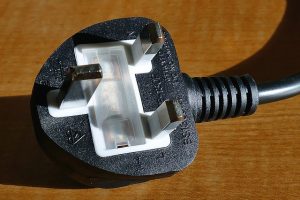
Many pieces of equipment will operate with a 13A supply, sometimes referred to as 'plug and play'. This simply means that it uses a standard 3 pin plug, generally supported by all buildings. Refrigeration can be plugged straight in and is ready to use without intervention from a professional electrician.
Larger display fridges and glass door freezers may require a 20A supply which is generally a single phase hardwired connection. You will need to enlist a qualified electrician to help with installation.
Some commercial refrigeration will use a 3 phase supply. If you come across 3 phase always make sure your building is wired accordingly and set up to support this system as converting can prove costly.
Cleaning and Maintenance
Any refrigeration designed for commercial use is designed to offer precision performance, enhanced efficiency and durability in tough working environments however these features all come at a cost. Equipment can be pricey and so it's vital to look after your investment and make sure that you get your money's worth.
Top Tips for Display Refrigeration Cleaning and Maintenance
- Regularly clean cabinets with a soft cloth and mild soapy water, not only for hygiene and food safety reasons but also to maintain the aesthetics of the display.
- Keep vents, fans and the condenser clear of dust and debris by either wiping with a cloth or lightly vacuuming.
- If manual defrost is required make sure it is carried out as soon as any ice build-up is noticeable. Never let the build-up exceed 1/4" thick.
- Regularly check door seals for signs of damage or wear and tear. Some fridges and freezers will have replaceable door gaskets meaning that basic maintenance work can be carried out in-house to prevent unnecessary escape of cold air.
- Service equipment using a qualified refrigeration engineer at least once a year.
Choose your Warranty
The warranty supplied as standard with glass door refrigerators will vary with each manufacturer. Always double check exactly what you are being offered and if there is an option to upgrade. With some units having a full parts and labour warranty others will offer parts only meaning that should any problems arise you will need to cover the cost of all labour.
Warranties are typically offered over 12 or 24 months however some manufacturers will provide a longer warranty. Visit our Commercial Warranties page for more information about levels of cover, what they include and the process should you need to make a warranty claim.
We Recommend:

Where a warranty option is available we always recommend opting for the longest, most comprehensive level of cover available. This fully protects you and eliminates any surprise expenses should an issue arise due to manufacturer fault or mechanical failure.
When Can You Expect Delivery?
The length of time for delivery will depend on the manufacturer and the type of equipment. Deliveries may be made in 2-3 working days, 3-5 working days or as a next day service (optional and chargeable in some cases). Larger equipment may have a lead time of 6-8 weeks or may be made to order. If you have questions regarding delivery you may find the answer in our Frequently Asked Questions section or alternatively, if you'd prefer to speak to a member of the team, give us a call on 01455 815200.
Ask advice
The options available to you should be coming clear however for additional advice you could look to friends who are in the same business. Remember that their recommendations will be based on what works for them and you may have different requirements to theirs. Alternatively, you could enquire with an impartial and unbiased supplier such as FFD who can listen to your requirements and provide valid suggestions for you to choose from, making the process much easier.

Leave a Comment
Your email address will not be published. Required fields are marked *